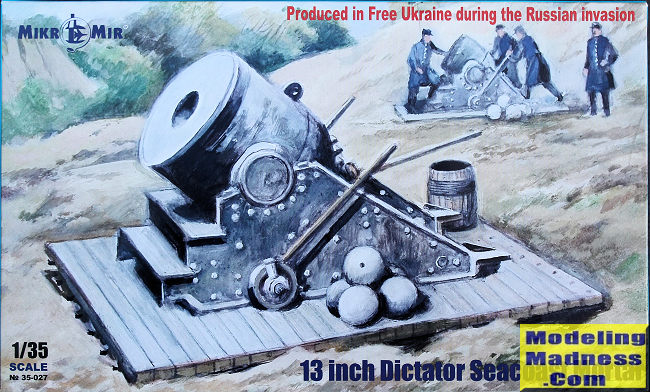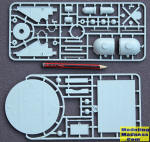
Mikro Mir 1/35 13" Seacoast Mortar
| KIT #: | 35-027 |
| PRICE: | AU$40.00 |
| DECALS: | None |
| REVIEWER: | George Oh |
| NOTES: | ‘Produced in Free Ukraine during the Russian Invasion’ |

| HISTORY |
Gunpowder burns very quickly. When it does, its transformation from a solid form into gas is accompanied by a lot of light, sound, heat and force that disperse all directions. To use the force element to push a projectile in a single direction requires corresponding resistance to channel the force into that direction. Surrounding it inside an iron tube does that nicely. In the early days of artillery, iron wasn’t as strong as its potential, so to contain (and direct) the force of the gunpowder, LOTS of iron was needed to surround it. The more gunpowder used, the greater was the resultant force, so the thicker the surrounding iron had to be.
During the American Civil War, the largest-calibre weapon available to the Union/Federal Armies, was the 13” seacoast mortar. It used 20 pounds (@ 9kg) of gunpowder to hurl a 220-pound (@ 100kg), 13”-diameter (@ 330mm) shell over 4,200 yards (@ 4km) away, in spite of its relatively-short length. Cast in a Pittsburgh foundry with a very-thick wall, it weighed 17,120 pounds (@ 7765kg), which dictated that it be moved by, and fired from, a railway flatcar or ship.
‘The Dictator’ was the most famous of them all, because it was photographed so many times (and we humans STILL photograph the biggest, baddest, most-impressive stuff around). Served by Company G of the 1st Connecticut Heavy Artillery Regiment, it first went into action on 9 July, 1864 by lobbing shells into the city of Petersburg, Virginia and at the Confederate Chesterfield artillery battery on the other side of the Appomattox River, from a specially-reinforced railway flatcar. In-service till September, it fired 218 rounds. The fate of this famous gun is unknown, though it was probably quietly sold as scrap iron after the War (though replicas do exist).
The internet is singularly unhelpful on the outside diameter of ‘The Dictator’ (the model scales-up to 1.085m in diameter x 1.26m in length), the number of them produced, or what the shells were filled with.
| THE KIT |
 This short, squat weapon
is an unusual-looking, when compared to 20th (and 21st) Century artillery
pieces. I bought it for that reason, and to support the fight for Freedom.
It is crisply-moulded in two sprues of 37 parts, though a little mould seam
is visible. As there are no markings, you could build this as ‘The Dictator’
or any other seacoast mortar and you have the option of mounting it on a
‘wooden’ turntable or platform. The kit includes a barrel (of gunpowder?)
and 4 spherical shells. Photos show ‘The Dictator’ with a flat face, whereas
this model has a slightly-wider recessed rim around the bore. A gun-crew
(posing with it? loading it? firing it?) would be a nice addition or
after-market option.
This short, squat weapon
is an unusual-looking, when compared to 20th (and 21st) Century artillery
pieces. I bought it for that reason, and to support the fight for Freedom.
It is crisply-moulded in two sprues of 37 parts, though a little mould seam
is visible. As there are no markings, you could build this as ‘The Dictator’
or any other seacoast mortar and you have the option of mounting it on a
‘wooden’ turntable or platform. The kit includes a barrel (of gunpowder?)
and 4 spherical shells. Photos show ‘The Dictator’ with a flat face, whereas
this model has a slightly-wider recessed rim around the bore. A gun-crew
(posing with it? loading it? firing it?) would be a nice addition or
after-market option.
The painting guide (and historical photos) advises that the mortar is black and its cradle is ‘dark iron’. The kit’s biggest challenges for the modeller would be to 1) accurately represent the colours while avoiding a monochrome finish and 2) replicate the rough cast texture of the gun (by stippling-on the paint?). Personally, replicating the wood of the platform, turntable and barrel would be equally-challenging. I would probably paint each as a separate sub-assembly, before final assembly.
| CONCLUSIONS |
I’ve never seen a model of this mortar before, so, for me, this is a very-welcome kit. It appears to be a quick build and easy to paint (no masking required).
August 2023 Copyright ModelingMadness.com.
All rights reserved. No reproduction in part or in whole without express
permission. If you would like your product reviewed fairly and
fairly quickly, please
contact
the editor or see other details in the
Note to
Contributors.